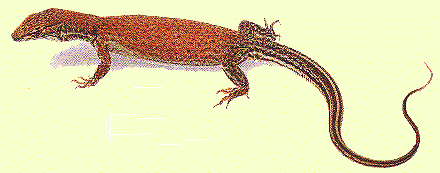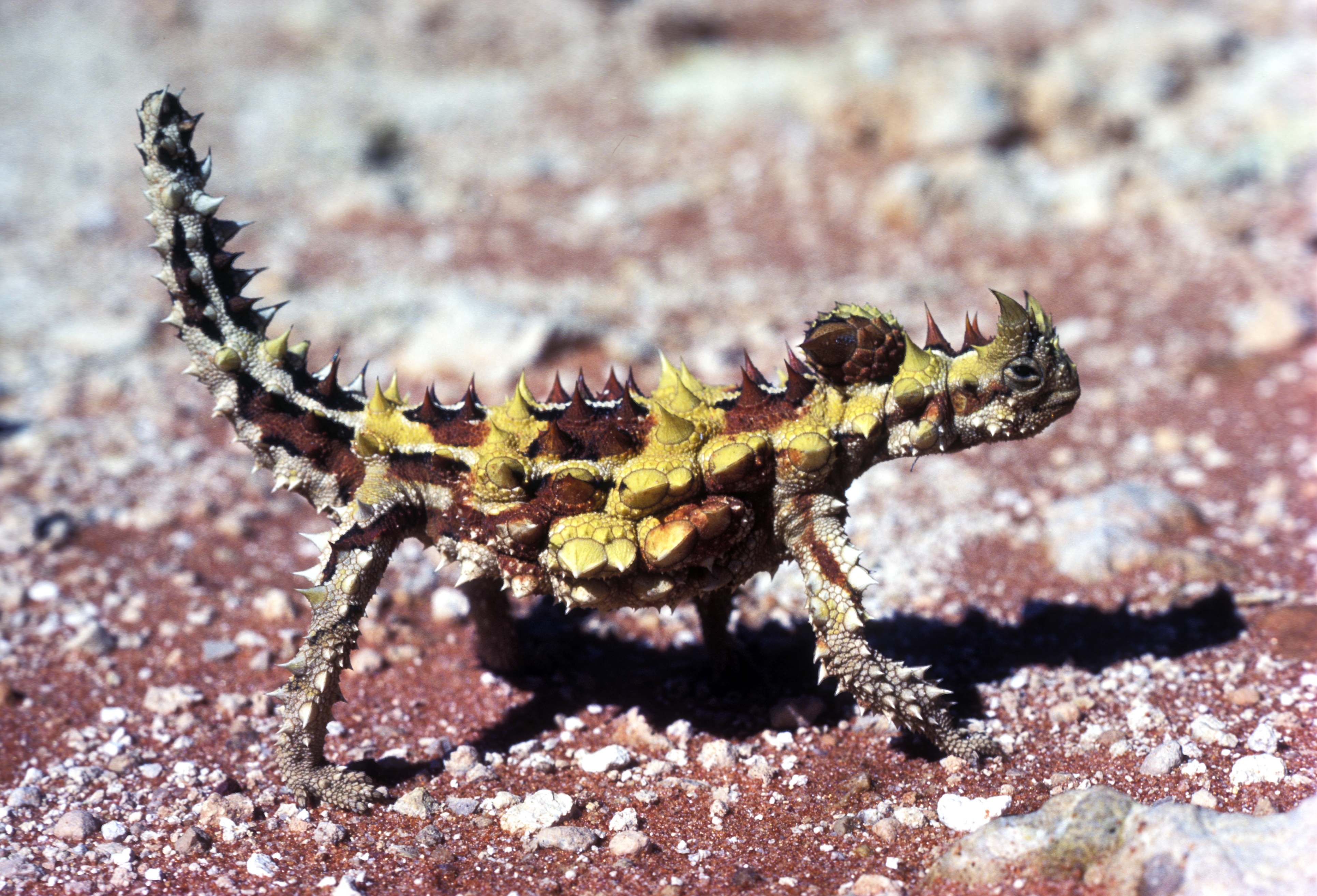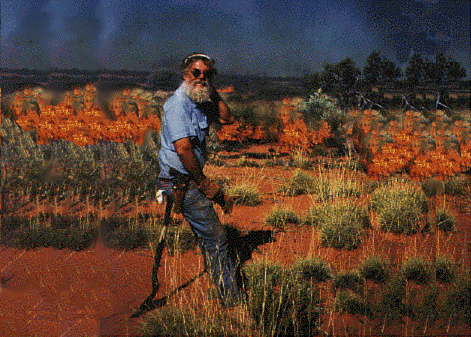 Why are the Australian deserts so rich in species of lizards? The challenge of explaining this high diversity, and of understanding what goes on between component species, is awesome. Compared to Australia the North American deserts are impoverished, with only a dozen species of lizards; in the Kalahari semidesert of southern Africa, only 20 species occur. How do so many lizards avoid competition and manage to coexist? How do they partition resources such as food and microhabitats? Ecologists still know surprisingly little about exactly how diverse natural ecological systems function -- ecological understanding that is much needed and will be critical to our own survival as well as that of other species of animals and plants. In fact, the Australian deserts probably offer the last opportunity to study the regional effects of disturbance on local diversity.  Coexistence Lizards divide up environmental resources in three major ways: by being active at different times, by spending time in different places, and by eating different foods. Such ecological differences reduce competition, allowing coexistence. Many lizard species are food generalists, eating a wide variety of arthropods. However, some other species of lizards are dietary specialists, with certain species eating only ants, others termites, and still others almost nothing except other lizards. One species, Pygopus nigriceps, preys heavily on scorpions. Like the North American iguanid horned lizards (genus Phrynosoma), the Australian agamid Moloch horridus eats virtually nothing but ants. Such pairs of convergent species are known as ecological equivalents, occupying roughly similar ecological roles in different biogeographic regions. Lizards also differ in their choice of microhabitats: some climb, others are terrestrial, while still others are fossorial, swimming through the sand. Some species frequent the open spaces between spinifex tussocks, whereas others seldom leave the protective cover of spinifex. Lizards constitute an extremely conspicuous element of the vertebrate faunas of most deserts, especially warmer ones. Indeed, in "The Red Centre" the Australian mammalogist H. H. Finlayson referred to the vast interior deserts of Australia as "a land of lizards." Ectothermy enables the body's metabolism to slow right down, allowing lizards to capitalize on scant and unpredictable food supplies. Moreover, along with other ectotherms, lizards are low-energy animals. Endothermy is much more expensive energetically. One day's food supply for a small bird will last a lizard of the same weight for over a month. Ectothermy thus has distinct advantages over endothermy under the harsh and unpredictable conditions that prevail in deserts. By means of this thermal tactic, lizards can conserve water and energy by becoming inactive during the heat of midday, during resource shortages, or whenever difficult physical conditions occur (such as during heat waves or droughts). Birds and mammals must weather out these inhospitable periods at a substantially higher metabolic cost. Hence ectothermy confers a competitive advantage on lizards over endotherms in desert environments. Fire in the Australian desert The very flammable hummock grass plant life form is unique to Australia. Spinifex tussocks are perfectly designed for combustion, consisting of hemispherical clumps of numerous match-stick sized blades of dry curled grass filled with flammable resins, loosely interpenetrating one another and laced with ample air spaces. With such ideal tinder, one match is all that is required to start a bonfire. Spinifex has been called an "ideal pyrophyte." Some authorities think that the extensive grasslands in Australia were formed and maintained by regular aboriginal burning and that over many thousands of years aborigines acted to select members of plant communities for resistance to fire or for an ability to come back quickly following a fire. Most early explorers and historians of Australia commented on the extent to which the aborigines exploited fire. Spinifex grasses give off dark smoke which can be seen from afar. Australian aborigines used fire to send long distance smoke signals, to manage habitats and keep terrain open, as well as to facilitate capture of various animals for food. 
ERP conducting the controlled burn of the B-area. Upon ignition, an isolated grass tussock generates an egg-shaped thermal field around it. At low wind velocities, isotherms for such fields are symmetric and close to the combustibles, but as wind speed increases, thermal fields become asymmetric and extend farther out, especially downwind. If other tussocks are within such a field's threshold temperature for ignition, they too are lighted and the fire spreads. Due to the geometry of thermal fields generated, fires tend to burn along broad continuous fronts at low wind velocities, whereas at higher wind velocities, elongate narrow tongues of flame are produced. Fires are more likely to break up at higher wind velocities due to these elongated tongues of flame. Previously burned areas have sparser vegetation and act as gigantic fire breaks. Sandridges and termitaria create smaller vegetationless areas that also act as local fire breaks, but with fundamentally different geometries and at very different spatial scales. Airborne flaming materials, termed "firebrands," may jump over unburned areas to rekindle new fires on the downwind side of a fire, sometimes resulting in establishment of multiple fire fronts (these can extinguish one another when one runs into another's swath). "Sleepers," embers created from burning hard wood of Eucalyptus, lay dormant in burned areas, only to re-ignite at the edges days or even weeks later when new strong winds come up. New secondary bush fires begin that take off at an angle to the immediately previous primary burn, resulting in an interesting net-like pattern that generates a patchwork of refuges. Major factors that determine the frequency, extent and geometry of grassfires include temperature, combustibility, plant biomass and spatial distribution, natural firebreaks, and of course, winds, which as explained above, are of paramount importance. A fire succession cycle helps to explain the high lizard diversity of the Australian interior. Fires are a predictable event in arid Australia, and generate a mosaic of patches of habitat at various stages of post-fire succession. As a more or less regular agent of disturbance, fires contribute substantially to maintaining diversity in Australian desert lizard systems. Bush fires are usually started by lightning, and can rage completely out of control for weeks on end across many square kilometers of desert. Fires vary considerably in intensity and extent. Eucalyptus trees are fire resistant and usually survive a hot but brief ground fire carried by the exceedingly flammable Triodia grass tussocks. Moreover, fires frequently spread like a net, missing an occasional isolated grass tussock or even large tracts. Effects on lizards and lizard microhabitats are drastic, yet vary from place to place. Many or even most individual lizards live through the burn itself, only to succumb in the fire-reduced habitats and microhabitats that can last for years. Fires attract hawks and crows, which feed on fire-killed animals and take advantage of the lack of cover to catch survivors. Some lizard species with open habitat requirements (such as Ctenophorus isolepis, Ctenophorus inermis and Ctenotus calurus ) reinvade and repopulate burned areas rapidly. Other species (such as Delma butleri, Omolepida branchialis, and/or Diplodactylus elderi) require large spinifex tussocks for microhabitats and become very rare or vanish after a burn. However, such "climax" species (those living in long-undisturbed habitat) can continue to exist in isolated pockets and patches of unburned habitat. Spinifex rejuvenates rapidly from live roots as well as by seedling establishment. Newly-burned areas are very open with lots of bare ground and tiny, well-spaced, clumps of Triodia. Unburned patches, in contrast, are composed of large ancient tussocks, frequently close together with little open space between them. As time progresses, Triodia clumps grow and "close in," gradually becoming more and more vulnerable to carrying another fire. Throughout this process, lizard microhabitats (and associated food resources) change. Lizard numbers fluctuate along with them. Numbers also alter substantially through succession, with some common species becoming quite rare. Rare species do not always remain rare and may be vitally important to hold a system together, allowing the system to respond to changing environmental conditions. A particular lizard species can even go extinct within a given area (known as a "sink" habitat), but by surviving in an adjacent patch (a "source" habitat) can still survive in the region. Periodic recolonization of "sinks" from "sources" allows such species to continue to persist in the overall landscape. Satellite imagery provides a powerful new way to study the dynamics and geometry of wildfire. In inland Australia, cloud cover is usually low or non-existent and excellent imagery is the rule. This facilitates analyses on a region-wide basis. Whereas ash absorbs infrared, unburned vegetation reflects it. The sizes and geometry of fires can be readily measured and fire scars traced through time. Frequency distributions of the ages and sizes of fire scars can be estimated and examined to see how often a particular area is burned. In such a large natural region, habitat patches at different stages of post-fire recovery can reach a dynamic equilibrium: new burns continually arise from older, thicker, more combustible stages of fire succession. Reflectance properties recorded from space could allow scientists to estimate the present state of all animal and plant life (biotas) in the region, as well as the climate during the immediate past. Careful field work is needed to learn the extent to which changes over time in patterns of reflectance can be extrapolated to fire-succession patterns on the land. Although a great deal more remains to be known, monitoring habitats and biotic diversity from satellites could ultimately prove to be possible in arid regions. Disappearing Wilderness Most people consider biology, particularly ecology, to be a luxury that they can do without. Even many medical schools in the USA no longer require that their pre-medical students obtain a biological major. Basic biology is not a luxury at all, but rather an absolute necessity. Despite our human-centered attitudes, other life forms are not irrelevant to our own existence. As proven products of natural selection that have adapted to natural environments over millennia, they have a right to exist, too. With human populations burgeoning and pressures on space and other limited resources intensifying, we need all the biological knowledge that we can possibly get. Ecological understanding is particularly vital. There has to be a great urgency to basic ecological research simply because the worldwide press of humanity is rapidly driving other species extinct and destroying the very systems that ecologists seek to understand. No natural community remains pristine. Pathetically, many will disappear without even being adequately described, let alone remotely understood. As existing species go extinct and even entire ecosystems disappear, we lose forever the very opportunity to study them. Knowledge of their evolutionary history and adaptations vanishes with them: we are thus losing access to valuable biological information itself. Indeed, as H. Rolston remarks in "Duties to Endangered Species" (BioScience 35, 1985), "destroying species is like tearing pages out of an unread book, written in a language humans hardly know how to read". Just as ecologists in many parts of the world are finally beginning to learn to read the "unread" (and rapidly disappearing) "book", they are encountering governmental and public hostility and having a difficult time finding support. Australia has been undergoing a gradual natural process of desertification for the last million years, but that process has accelerated greatly during the past century due to human activities, particularly agricultural clearing and overgrazing and the burning of fossil fuels. As our population burgeons and we destroy the last remaining natural habitats, earth's atmosphere is being altered at an ever increasing rate, leading to weather modification. Long-held meterological records the world over are being broken: a few years ago, the lowest low ever recorded (hurricane Gilbert) in late summer was followed in winter by the highest high on record. In 1991, Perth experienced the highest temperature (48Ť C) ever recorded in 150 years of habitation. Global warming is having its impact on virtually all plants and animals, including humans, and its effects will continue to intensify into the forseeable future. Crop failures and other ecocatastrophes would seem to be inevitable. Fires were once a major agent of disturbance in all grasslands and semideserts, including African savannas and the North American tall grass prairies. These ecosystems have now been reduced to mere vestiges, and controlled burning and/or fire control are practiced by humans almost everywhere. The inland Australian desert is one of the last remaining areas where natural wildfires are still a regular and dominant feature of an extensive natural landscape largely undisturbed by humans. (Aborigines do increase the frequency of fires, but the vast majority are started by lightning.) The Australian deserts contitute an exceedingly valuable system for the study of large-scale community ecology. Inroads on the wilderness have gone far enough. In both North America and in the Kalahari, most of my study sites have succumbed to farming and urbanization, as have deserts almost everywhere. So far, the spinifex desert has resisted the advancing human exploiters. Some people dream of the day that technological "advances," such as water movement plans or the distillation of sea water, will make it possible to replace the Australian deserts with vast agricultural fields or even cities. I fervently hope that this never happens, for if it ever should, the quality and dignity of our lives will be sadly diminished. 
Return to Pianka lab page |